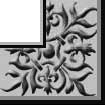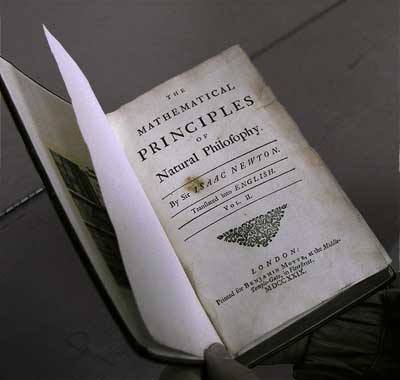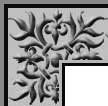
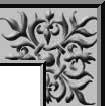
Newton: Planets, Apples, and Scientific Revolution
Theo Kalikow
|
The scientific progress from Ptolemy's geocentric universe to Newton's mathematical definition of the elliptical orbits of the planets produced multiple revolutions, but none so far-reaching as that of Newton's physics. |
|
|
|
Newton shown behind an armillary sphere with Earth at the center. Click to enlarge. |
The following is a summary of Dr. Kalikow's presentation:
I heard on the radio yesterday that it was the 100th anniversary of e=mc2 but it was also the 318th birthday of m! Newton, is of course, the person who made mass a scientific and lawful concept. But before we get into that we have to look at the history of the problem.
Even before there was a written record there was an oral tradition of
astronomy. In caves we find marks indicating that people followed the
phases of the moon, kept track of stellar objects and paid attention to the
sky above them. All over the world, each civilization carried out
traditions of astronomy whether for agriculture or travel. What is
common to all of these traditions is the assumption that the earth is the
center of the universe. If you get outside and look at the sky, that
is what it looks like. This is called the two-sphere universe -- the
earth in the center and a second sphere rotating around it. Very early
in history, people realized that the earth was a sphere, not flat. A
librarian, Eratosthenes, actually measured the circumference of the earth in
the third century BC.
Around 300 BC, Aristotle codified all of the traditions into a single system. The earth was the center and all bodies would fall toward it. The heavens were perfect and motion in the heavens would be perfectly circular. If there were no planets we might still be there. The planets move in peculiar ways given the Aristotelian method. Ptolemy in 150 AD collected all the observations he could find and made ingenious mathematical models to explain the planetary motions. (Chris Magri went into this in some detail).
This was the situation up until 1543 when Copernicus proposed the heliocentric system. There was no physics to support it but Copernicus solved the problem of the planets with a sun centered universe. If Earth is a planet going around the sun, how do you explain the motions on earth and the motions in the heavens? Tycho Brahe attempted to solve the problem and refine the data by making more exact observations. He used very very large instruments to increase the degree of accuracy of positional measurements. If you have a measuring stick on the side of a building rather than a small ruler, you are going to be able to measure a degree of arc much more accurately. Kepler studied Brahe's data to create a system that would fit the data. Kepler tried to make circles work but they were only accurate to 8 minutes to degree of arc and Brahe's data was accurate to 4 minutes to degree of arc. After many years of work Kepler found that the only thing that would work was elliptical orbits for the planets going around the sun at the center. There still was no physics to back it up, still no understanding of why it should work.
Galileo (1564-1642) was the first to have a new astronomical instrument -- the telescope. He used it to look at all sorts of things. He pointed it at the moon and was actually able to see that it had mountains on it and was able to measure their height by the shadows they cast. He saw the phases of Venus and the moons of Jupiter. The moons of Jupiter provide a model of how the solar system could work. Galileo had the first new data and method of seeing the universe. He didn't like the ellipses of Kepler, preferring circles. He still didn't have the physics to explain the motion of the planets. If the sun is the center of the solar system and the earth revolves around it, why don't things fall off the earth? That's how things stood until the time of Newton.
During the 16th century, the locus of scientific and political power had shifted from the south of Europe to the north primarily due to the building of ships for trade and defense. As this shifted the economy toward import/export and urbanization, it was recognized that the economy would do better if they knew more about navigation, natural phenomena, and of course astronomy. In 1660 a group of scientists including Wren, Boyle, Hooke, and Moray who had been meeting to discuss scientific matters established the Royal Society. People in other countries were also working on similar issues -- Descartes, Spinoza, Leibnitz -- and carried on lively correspondence throughout Europe.
In 1684 Halley goes to Newton to ask him about a question circulating at the time. If a force falls off as a square of the distance what shape would the orbit take? Newton said ellipse. How do you know? Newton said that he had proved it previously. Halley wants to see the proof and nags Newton until he finally sent it to him. Halley takes it to
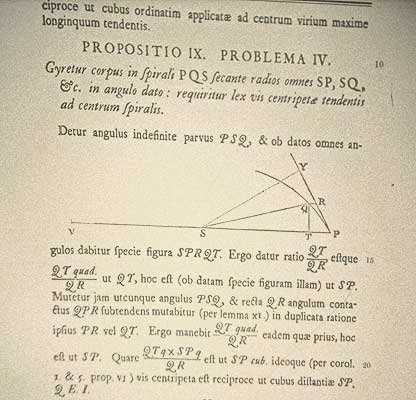 |
|
A page from the Principia in Latin |
the Royal Society and continued to nag Newton to write out his major theories. Finally, in 1687 the Principia (full title -- Philosophiae Naturalis Principia Mathematica) was published in Latin with the formal proofs of Newton's physics.
Newton was born the same year that Galileo died, 1642. He didn't show any signs of genius at an early age. He graduated from Cambridge and would have stayed on but 1665-1666 was a plague year and the universities closed. Newton stayed home for two years and thought about things. This appears to be the time that he created much of his later work. He didn't write much and didn't publish anything. He returned to Cambridge and two years later became the Lucasian Professor of Mathematics at age 26. His most famous early work is a paper on optics in which he showed that light was made up of waves.
 He
did a very simple experiment to prove it. He passed light through a
prism to produce a rainbow of colors. This had been seen often enough,
but he got a second prism and was able to show that by passing the rainbow
of light through it he could rejoin the different colors to produce the
original white light. In 1671 he published his paper on optics and
light.
It was his first scientific publication and it was the first scientific
paper on the physics of colors.
He
did a very simple experiment to prove it. He passed light through a
prism to produce a rainbow of colors. This had been seen often enough,
but he got a second prism and was able to show that by passing the rainbow
of light through it he could rejoin the different colors to produce the
original white light. In 1671 he published his paper on optics and
light.
It was his first scientific publication and it was the first scientific
paper on the physics of colors.
In the meantime, Newton continued to lecture on mathematics and began to get quite a reputation. His correspondence increased. But he found that when he wrote to other scientists they would write back and often wouldn't agree with him. He didn't like that. He tended to stay in Cambridge and avoid active contact with others. Thus, Halley had to come to him. History justifiably gives Halley great credit for the the Principia. He not only nagged Newton but edited and bore the cost of publication himself.
The Principia described the entire physical world using a single set of laws. The book is set up like a geometry with propositions, proofs and diagrams. It looks like geometry, but in fact all through the book Newton is using the calculus. The fundamental concept is the concept of limits. What happens when a fundamental quantity, ratio or proportion moves toward a vanishing point or starts at nothing and increases. That's the underlying mathematical thinking underlying the Principia and of course, Newton invented it.
Newton invented what he called mathematical philosophy but what we call mathematical physics. He used observation but relied on mathematics to refine his physics. This is the first comprehensive use of what we call the scientific method: creating hypotheses, doing experiments, refining the hypothesis and going back to make it into a theory.
The end product was not a collection of disjointed laws that applied to specific problems, but a cohesive set of laws within the theory that applied to all matter. These laws can be used to derive the predictions for all matter. For instance, he described the law of inertia: a body at rest tends to remain at rest, a body in uniform motion in a straight line will go on forever. It is indifferent which state of motion is true. Those are the only two natural states of motion. The circles of Copernicus are excluded from the natural state.
Newton also invented the concept of mass. The quantity of matter that adheres in a body is important, its weight will vary depending on conditions, but its mass will remain the same. Another law from Newton is universal gravitation. Between any two bodies in the universe there is a force of attraction which is mutual, and is directly proportional to the product of the two masses and inversely proportional to the square of the distance between the two bodies.

With these tools and a few others Newton could explain the planetary
orbits, the behavior of falling bodies near the earth and the tides.
The laws apply to everything, including apples. Basically what Newton
said is that the apple falls from the tree because it and the earth are
attracted to each other and the earth is a lot bigger. The apple is
just like the moon. It and the earth are also attracted to one
another, so why doesn't it fall? Newton says because it is affected by
another law, the law of inertia.

The moon is trying to fall toward the earth and it is also trying to fall into outer space. At every point on the orbit, both laws are at work. The result is that the moon is trapped into an orbit. A similar explanation describes the effect on the planets as they revolve around the sun.
Newton was able to apply the same laws to describe the apple, the moon, and the planets. When the book came out, it caused a sensation. Within about 40 years or so everybody was a Newtonian.
Newton became a celebrity. He became president of the Royal Society in 1703 and was knighted in 1705. He published Opticks in 1704. He produced revised editions of the Principia in 1713 and 1726.

The Principia provided the solution to a 10,000 year old problem. It showed people what they could do with science. Using a system of laws, theorems and proofs it provided a universal system for understanding the physical world. It is taken as a model by other fields of science like chemistry but also as a model in the social realm. In politics it triggered a search for mechanisms or systems. It engendered a belief that there were systems which people could find that would be better. By extension it supported the growth of the belief that there should be more revolutions, more change, as people discovered better systems.
The Enlightenment of the 18th century was strongly influenced by Newton's revolution. The goal of philosophers like Voltaire, Rousseau, Locke, or Hume was to understand everything and that included the social world. The search was on to find universals, one of which was equality. The application of equal rights, a universal set of principles, as well as the concept that our understanding of the world could change underlay a century of political, social, and economic revolution and our own Constitution.
The 19th century built upon Newtonian physics with each science working toward finding and describing the system that connected the minutia of observation and away from minor models that described limited sets of data. Newton is responsible for the physics behind the space program, meteorology, hydrology, and a vast array of other scientific and social changes that depended on the model in the Principia. Even the Einsteinian revolution follows the Newtonian model of searching for a set of universal laws that will govern everything and supports the principle that revolutions will continue to happen as knowledge is not static.
The audience was able to examine a copy of the first English edition of the Principia published in MDCCXXIX.
 |
 |
| Click on book images for enlargement | |
|

